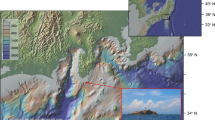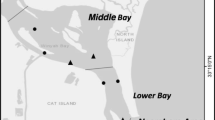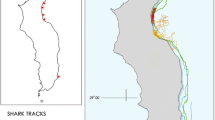Abstract
Sphyrna lewini is a viviparous shark that pups in shallow coastal waters. Given dramatic declines in the S. lewini Eastern Pacific population, it is essential to identify nursery grounds that could potentially increase the resilience of adult populations. Here, we provide evidence of a putative nursery ground for S. lewini at an oceanic island in the Galapagos Marine Reserve. A fortuitous finding of hammerhead shark pups in 2017 led to a series of focused surveys from 2018 onwards, using experimental fishing, baited remote underwater videos stations (BRUVS), and acoustic telemetry, to assess presence and residency patterns of this species at Puerto Grande: a shallow bay at the island of San Cristobal. We caught 66 individuals, of which we measured 54 (mean TL = 52.13 cm). Four individuals were fitted with ultrasonic tags and were detected on an array of 14 receivers in the bay for up to 93 days, showing a high residency index of at least 89%. We actively tracked a single individual for 3 h at night and a further hour a week later. Our results suggest that Puerto Grande is a key habitat for the development of the critically endangered S. lewini.




Similar content being viewed by others
Data availability
All authors declare that all data and materials support the published claims and comply with field standards.
Code availability
Not applicable.
References
Alejo-Plata C, Gómez-Márquez JL, Ramos S, Herrera E (2007) Presencia de neonatos y juveniles del tiburón martillo Sphyrna lewini (Griffith & Smith, 1834) y del tiburón sedoso Carcharhinus falciformis (Müller & Henle, 1839) en la costa de Oaxaca, México. Rev Biol Mar Oceanogr 42:403–413. https://doi.org/10.4067/S0718-19572007000300020
Anislado - Tolentino V, Robinson - Mendoza C (2001) Age and growth for the scalloped hammerhead shark, Sphyrna lewini (Griffith and Smith, 1834) along the Central Pacific Coast of Mexico. Cienc Mar 27:21
Bejarano - Álvarez M (2007) Biología reproductiva del tiburón martillo Sphyrna lewini (Griffith y Smith, 1834) en Salina Cruz, Oaxaca, México. Dissertation, Centro Interdisciplinario de Ciencias Marinas - Instituto Politécnico Nacional
Bessudo S, Soler GA, Klimley AP et al (2011) Residency of the scalloped hammerhead shark (Sphyrna lewini) at Malpelo Island and evidence of migration to other islands in the Eastern Tropical Pacific. Environ Biol Fishes 91:165–176. https://doi.org/10.1007/s10641-011-9769-3
Castro JI (1993) The shark nursery of Bulls Bay, South Carolina, with a review of the shark nurseries of the southeastern coast of the United States. Environ Biol Fishes 38:37–48. https://doi.org/10.1007/BF00842902
Carlson JK (1999) Occurrence of neonate and juvenile sandbar sharks, Carcharhinus plumbeus, in the northeastern Gulf of Mexico. Fish Bull 5
Chiriboga - Paredes YT (2018) Ecología espacial y conservación de tiburones neonatos y juveniles punta negra (Carcharhinus limbatus) en la Isla San Cristóbal – Reserva Marina de Galápagos. Dissertation, Universidad San Francisco de Quito
Clarke TA (1971) The ecology of the scalloped hammerhead shark. Sphyrna Lewini in Hawaii Pac Sci 25:12
Duncan KM, Holland KN (2006) Habitat use, growth rates and dispersal patterns of juvenile scalloped hammerhead sharks Sphyrna lewini in a nursery habitat. Mar Ecol Prog Ser 312:211–221. https://doi.org/10.3354/meps312211
Espinoza M, Farrugia TJ, Lowe CG (2011) Habitat use, movements and site fidelity of the gray smooth-hound shark (Mustelus californicus Gill 1863) in a newly restored southern California estuary. J Exp Mar Biol Ecol 401:63–74. https://doi.org/10.1016/j.jembe.2011.03.001
Froeschke J, Stunz G, Wildhaber M (2010) Environmental influences on the occurrence of coastal sharks in estuarine waters. Mar Ecol Prog Ser 407:279–292. https://doi.org/10.3354/meps08546
Goodman LS (2020) Feasibility of new methods for nursery ground identification for the juvenile blacktip shark (Carcharhinus limbatus) using drone technology - San Cristobal Island, Galapagos. Dissertation, University of North Carolina at Chapel Hill
Hearn A, Ketchum J, Klimley AP et al (2010) Hotspots within hotspots? Hammerhead shark movements around Wolf Island, Galapagos Marine Reserve. Mar Biol 157:1899–1915. https://doi.org/10.1007/s00227-010-1460-2
Hearn AR, Acuna D, Ketchum JT, Penaherrera C, Green J, Marshall A, Guerrero M, Shillinger G (2014) Elasmobranchs of the Galapagos Marine Reserve. In: Dekinger J, Vinueza L (eds) The Galapagos Marine Reserve. Springer, Cham, pp 23–59
Heupel MR, Carlson JK, Simpfendorfer CA (2007) Shark nursery areas: concepts, definition, characterization and assumptions. Mar Ecol Prog Ser 337:287–297. https://doi.org/10.3354/meps337287
Hirschfeld M (2013) Habitat use and movement patterns of juvenile and neonate blacktip sharks, Carcharhinus limbatus in nursery areas on San Cristobal Island, Galápagos. Dissertation, Universidad San Francisco de Quito
Holland KN, Wetherbee BM, Peterson JD, Lowe CG (1993) Movements and distribution of hammerhead shark pups on their natal grounds. Copeia 1993:495–502. https://doi.org/10.2307/1447150
Ketchum JT, Hearn A, Klimley AP et al (2014) Seasonal changes in movements and habitat preferences of the scalloped hammerhead shark (Sphyrna lewini) while refuging near an oceanic island. Mar Biol 161:755–767. https://doi.org/10.1007/s00227-013-2375-5
Ketchum JT, Hearn A, Shillinger G, et al (2009) Shark movements and the design of protected pelagic environments within and beyond the Galapagos Marine Reserve. Puerto Ayora, Galápagos, pp 127–130
Klimley AP, Butler SB, Nelson DR, Stull AT (1988) Diel movements of scalloped hammerhead sharks, Sphyrna lewini Griffith and Smith, to and from a seamount in the Gulf of California. J Fish Biol 33:751–761. https://doi.org/10.1111/j.1095-8649.1988.tb05520.x
Llerena Y (2009) Identificación de tiburones juveniles y caracterización de sus hábitats en las zonas costeras de pesca de la isla San Cristóbal - Reserva Marina de Galápagos. Universidad de Guayaquil
Llerena Y, Peñaherrera C, Espinoza E, et al (2015) Áreas de crianza de tiburones punta negra (Carcharhinus limbatus) en zonas de manglar en la parte central del archipiélago de Galápagos. Galapagos Conservancy
Llerena-Martillo Y, Peñaherrera-Palma C, Espinoza ER (2018) Fish assemblages in three fringed mangrove bays of Santa Cruz Island, Galapagos Marine Reserve. Rev Biol Trop 66:674. https://doi.org/10.15517/rbt.v66i2.33400
Marie AD, Miller C, Cawich C et al (2017) Fisheries-independent surveys identify critical habitats for young scalloped hammerhead sharks (Sphyrna lewini) in the Rewa Delta, Fiji. Sci Rep 7:1–12. https://doi.org/10.1038/s41598-017-17152-0
Moity N, Delgado B, Salinas-de-León P (2019) Mangroves in the Galapagos islands: distribution and dynamics. PLoS ONE 14:e0209313. https://doi.org/10.1371/journal.pone.0209313
Nalesso E (2014) Distribución espacio-temporal de los tiburones martillo, Sphyrna lewini, alrededor de la Isla del Coco (2005–2013), Pacífico Tropical Oriental. Dissertation, Centro de Investigación Científica y de Educación Superior de Ensenada
Palomino AP (2019) Description of blue shark (Prionace glauca) and scalloped hammerhead shark (Sphyrna lewini) movements in the Galápagos Marine Reserve. Dissertation, Universitat de Barcelona - Universidad San Francisco de Quito
Papastamatiou YP, Friedlander AM, Caselle JE, Lowe CG (2010) Long-term movement patterns and trophic ecology of blacktip reef sharks (Carcharhinus melanopterus) at Palmyra Atoll. J Exp Mar Biol Ecol 386:94–102. https://doi.org/10.1016/j.jembe.2010.02.009
Parsons GR, Hoffmayer ER (2007) Identification and characterization of shark nursery grounds along the Mississippi and Alabama gulf coasts. Am Fish Soc Symp 50:301–316
Peñaherrera-Palma C, Van Putten I, Karpievitch YV et al (2018) Evaluating abundance trends of iconic species using local ecological knowledge. Biol Conserv 225:197–207. https://doi.org/10.1016/j.biocon.2018.07.004
Quintanilla S, Gómez A, Mariño-Ramírez C et al (2015) Conservation genetics of the scalloped hammerhead shark in the Pacific Coast of Colombia. J Hered 106:448–458. https://doi.org/10.1093/jhered/esv050
Rigby CL, Dulvy NK, Barreto R, et al (2019) Sphyrna lewini. The IUCN Red List of Threatened Species 2019: e. T39385A2918526
Robles PYA, Montes LA, Vega ÁJ (2015) Caracterización de la captura de tiburones por la pesca artesanal en los manglares de David, Golfo de Chiriquí, Pacífico de Panamá. Tecnociencia 17:11–30
Salinas-de-León P, Hoyos-Padilla EM, Pochet F (2017) First observation on the mating behaviour of the endangered scalloped hammerhead shark Sphyrna lewini in the Tropical Eastern Pacific. Environ Biol Fishes 100:1603–1608. https://doi.org/10.1007/s10641-017-0668-0
Simpfendorfer CA, Milward NE (1993) Utilisation of a tropical bay as a nursery area by sharks of the families Carcharhinidae and Sphyrnidae. Environ Biol Fishes 37:337–345. https://doi.org/10.1007/BF00005200
Stobart B, Díaz D, Álvarez F et al (2015) Performance of baited underwater video: does it underestimate abundance at high population densities? PLoS ONE 10:e0127559. https://doi.org/10.1371/journal.pone.0127559
Wetherbee BM, Gruber SH, Rosa RS (2007) Movement patterns of juvenile lemon sharks Negaprion brevirostris within Atol das Rocas, Brazil: a nursery characterized by tidal extremes. Mar Ecol Prog Ser 343:283–293. https://doi.org/10.3354/meps06920
White ER, Myers MC, Flemming JM, Baum JK (2015) Shifting elasmobranch community assemblage at Cocos Island-an isolated marine protected area: Elasmobranch Community Shifts. Conserv Biol 29:1186–1197. https://doi.org/10.1111/cobi.12478
Whitmarsh SK, Huveneers C, Fairweather PG (2018) What are we missing? Advantages of more than one viewpoint to estimate fish assemblages using baited video. R Soc Open Sci 5:171993. https://doi.org/10.1098/rsos.171993
Yates PM, Heupel MR, Tobin AJ, Simpfendorfer CA (2015) Ecological drivers of shark distributions along a tropical coastline. PLoS ONE 10:e0121346. https://doi.org/10.1371/journal.pone.0121346
Zanella I, Garro AL, Vargas RA (2009) Caracterización de la pesca del tiburón martillo Sphyrna lewini, en la parte externa del Golfo de Nicoya, Costa Rica. Rev Cienc Mar Costeras 1:175–195
Zanella I, López-Garro A (2015) Abundancia, reproducción y tallas del tiburón martillo Sphyrna lewini (Carcharhiniformes: Sphyrnidae) en la pesca artesanal de Golfo Dulce, Pacífico de Costa Rica. Rev Biol Trop 307–317. https://doi.org/10.15517/rbt.v63i1.23110
Zanella I, López-Garro A, McComb-Kobza DM, et al (2016) First record of young-of-the-year scalloped hammerhead shark, Sphyrna lewini (Carcharhiniformes: Sphyrnidae) from Isla del Coco National Park, Costa Rica. Rev Biol Trop 64:201. https://doi.org/10.15517/rbt.v64i1.23448
Acknowledgements
We thank the Galapagos National Park Services for institutional support and research permits (PC-34-17, PC-24-18, PC-13-19, and PC-64-20) that include approval for animal handling methods. Thanks to the Galapagos Science Center — Universidad San Francisco de Quito (GSC-USFQ) for institutional support. We thank the Galapagos Conservation Trust, National Marine Aquarium/Ocean Conservation Trust, The Rufford Small Grants for Nature Conservation, Prince Albert Foundation Grant through the Galapagos Conservation Trust, Galapagos Science Center POA Research Grants, and internal COCIBA Grants at USFQ for funding and support. We also thank the Fulbright Program and Monterey Bay Aquarium for the support of SJJ. The crew of the M/S Sea Quest and M/S Cormoran, Capitan Mauricio Hidalgo, provided indispensable support. Special thanks to Federico Idrovo-Bermeo, Kevin Cabrera, Henrry Vivanco, Cisne Zambrano, to all assistants, volunteers, and Galapagos National Park Wardens, for their invaluable knowledge and effort during the field and logistics.
Funding
This research was funded by the Galapagos Conservation Trust, National Marine Aquarium/Ocean Conservation Trust, The Rufford Foundation, Prince Albert II of Monaco Foundation Grant through Galapagos Conservation Trust, Galapagos Science Center POA Research Grants, and internal COCIBA Grants at Universidad San Francisco de Quito. Salvador Jorgensen was supported by the Fulbright Program and Monterey Bay Aquarium.
Author information
Authors and Affiliations
Contributions
YC-P participated in the fieldwork, data collection, data analysis, and is the main writer of the manuscript. ÁP and LG participated in the fieldwork, data collection, and review of the manuscript. FC and VP participated in the fieldwork and data collection. MY participated in the fieldwork and data collection and provided local information and experience. SJ provided guidance and participated in the field and data collection and review of the manuscript. DA participated in the fieldwork and data collection. DP participated in the fieldwork, data collection, and review of the manuscript. AH developed the study design, provided funding, participated in the fieldwork and data collection, provided supervision, organization, and review of the manuscript.
Corresponding author
Ethics declarations
Ethics approval
The methods used in this study were approved under research permits PC-34–17, PC-24–18, PC-13–19, and PC-64–20 and issued by the Galapagos National Park Directorate.
Consent to participate
Not applicable.
Consent for publication
All authors consent to the publication of the manuscript and declare that it has not been published in any other journal.
Conflict of interest
The authors declare no competing interests.
Additional information
Publisher's note
Springer Nature remains neutral with regard to jurisdictional claims in published maps and institutional affiliations.
Rights and permissions
About this article
Cite this article
Chiriboga-Paredes, Y., Palomino, Á., Goodman, L. et al. Discovery of a putative scalloped hammerhead shark Sphyrna lewini (Carcharhiniformes: Sphyrnidae) nursery site at the Galapagos Islands, Eastern Tropical Pacific. Environ Biol Fish 105, 181–192 (2022). https://doi.org/10.1007/s10641-021-01207-3
Received:
Accepted:
Published:
Issue Date:
DOI: https://doi.org/10.1007/s10641-021-01207-3




